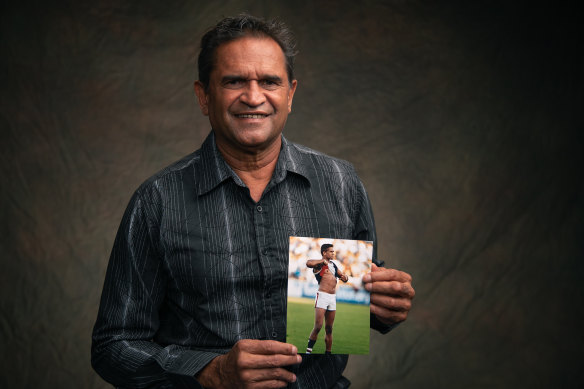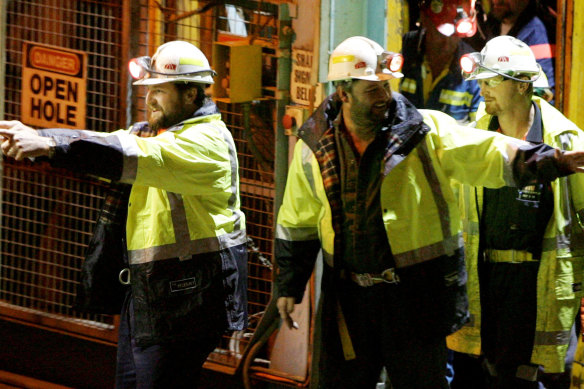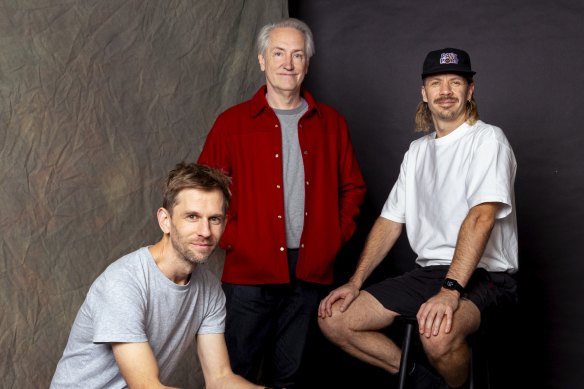An ordinary day became extraordinary: that’s the key to this elegant series
By Debi Enker
Criticism of the ABC is constant in the TV world and it comes from both ends of the spectrum: from those who fundamentally object to the existence of a publicly funded national broadcaster and from dedicated devotees of the network dismayed by its decisions. But one thing that ABC TV has got absolutely right is its support for the work of Kirk Docker and his screen producing partner, Aaron Smith.
The pair, who initially worked together as promising newcomers on Hungry Beast (2009-11), first gave us the treasure You Can’t Ask That, a series that’s run here for seven seasons and in a format that the ABC has sold around the world.

Nicky Winmar in the ABC TV factual series I Was Actually There.Credit: ABC
YCAT asks probing questions of people who might not ordinarily get a chance to discuss their lives and experiences: suicide-attempt survivors, ex-prisoners, gambling addicts, porn stars, amputees. They’re people whose characteristics or experiences might make others uncomfortable, but also curious. Their stories invariably have a unifying effect, inspiring an appreciation that everyone has their trials, fears, insecurities, heartbreaks and losses, that people can be vulnerable and resilient.
The series is driven by an underlying belief that, if one takes the time to ask and to listen, these stories will be worth hearing. For reasons of economy and utility, the interviewees are positioned in front of a white roll-up screen, a deft production decision that became one of the show’s trademarks.
Like the ground-breaking YCAT, director Docker and cinematographer Smith’s latest venture, the documentary series I Was Actually There, created with former Hungry Beast producer Jon Casimir, is elegant in its simplicity and brilliantly effective in achieving its goals. IWAT is original and inventive, cleverly constructed and quietly powerful. The concept is so smart and the production so well executed that it makes you wonder why no one has thought of it before, which is always a telling measure of a great idea.
Comprising half-hour episodes, the six-part series (Tuesdays, 8pm, and all available on iview) focuses on a selection of significant events, presenting them from the perspective of those who, for a range of reasons, were directly involved.
It’s an eclectic mix, taking in a natural disaster, man-made tragedies, an entertainment-industry phenomenon, a sporting milestone and a political protest. It opens with the 1996 Port Arthur massacre and also features the 2004 Boxing Day tsunami, AFL player Nicky Winmar’s iconic black pride gesture at Victoria Park in 1993, The Beatles’ 1964 visit to Adelaide, the 2002 breakout from the Woomera detention centre, and the 2006 Beaconsfield mine collapse.
For many of those involved, the event under consideration proved life-changing, as well as subsequently having a wider social impact. Yet what emerges in each episode is that a seemingly ordinary day unexpectedly becomes extraordinary.
With the tsunami episode, for example, there are reflections from a number of people caught up in the disaster: tourists on eagerly anticipated holidays, others who’d impulsively opted for a mini-break at a Thai resort, a local business owner who was visiting for meetings. It’s the familiar stuff of everyday life, after which people find themselves propelled into situations that they could never have imagined.
In addition to being a strong concept featuring a smart selection of subjects, IWAT is enhanced by its execution: a judicious choice of contributors, the polished staging of interviews, the fluidity with which accounts are woven together and the sparing but evocative use of archival footage. Through the mosaic of perspectives, events that might previously have seemed exhaustively documented feel fresh and alive.

Todd Russell (left) and Brant Webb emerge from the Beaconsfield mine after their rescue.Credit: Getty
The episodes have a straightforward chronological structure. A concise introduction provides context, using archival footage to set the scene. It’s followed by accounts of how events unfolded, consideration of their impact, and reflections on the aftermath. As with YCAT, a house style is established. Here, people sit in front of a grey-green canvas backdrop that somehow manages to be classy and oddly calming.
The interviewees aren’t identified by on-screen titles, although they’re all listed in the end credits. That choice, eschewing the familiar news and current-affairs style, makes this production seem more intimate: the testimonies feel more direct and personal. It also democratises the process: all the contributors are equally valid and equally valuable.
In the Port Arthur episode, a chef at The Broad Arrow Cafe, a police sniper, a local GP and victims of the shooting all appear, their roles in the attack emerging through their accounts of what they saw, did and felt. And you might think that you know a lot about the Tasmanian mine disaster and the almost-miraculous rescue of miners Todd Russell and Brant Webb after 321 hours trapped under 12 metres of rock. But here, as well as hearing from the men about their horrifying ordeal, you hear from mine managers, family members, townsfolk, journalists and members of the rescue team.

I Was Actually There co-creators (from left) Aaron Smith, Jon Casimir and Kirk Docker, in front of their bespoke backdrop.Credit: Dominic Lorrimer
As a result, the series is rich with the kind of impressionistic detail that makes this version of history so compelling. On the scene in Port Arthur as mass-murderer Martin Bryant runs semi-naked from a burning house, police sniper Craig Harwood, who subdued the killer with mace spray, recalls: “He had very blue eyes. You understand a lot about a character when you look into someone’s eyes. He had blue marbles, you just stare straight through them: nothing.” From a man who appears unflappable and accustomed to dealing with danger, the observation is telling and chilling.
Docker is a gifted storyteller and, with his collaborators, he’s again created something special. But in addition to its value as a documentary, IWAT demonstrates the ABC’s critical role as a training ground. Docker and Smith are among the fledgling talents that emerged from Hungry Beast, along with Marc Fennell, Dan Ilic and Kirsten Drysdale. Before it came Attitude (1993-95), an energetic and innovative current-affairs show also focused on nurturing new talent. In addition to introducing Aaron Pedersen, who was at that stage training as a journalist, it provided an early foothold in the industry and invaluable experience for a host of journalists and producers who went on to helm shows including Australian Story, Back Roads and Insight.
Over the years, many avenues for hands-on training have disappeared. And, given the current, shaky state of the TV industry and its predominantly casualised workforce, it’s more important than ever that the ABC fills that gap. As this standout series attests, the rewards for the broadcaster and the viewing public are substantial.
Find out the next TV, streaming series and movies to add to your must-sees. Get The Watchlist delivered every Thursday.